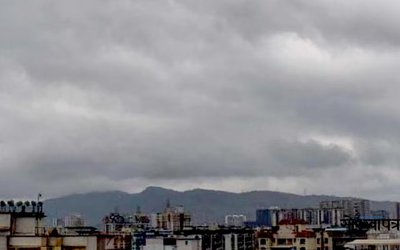
By Rabindra Bahadur Singh
A simple act of collective procurement is improving the access of the earthquake victims to quality construction materials and reducing the price by more than 10 percent.
Two years after the devastating earthquake, the majority of the victims are still under the temporary shelters in Nepal. Their journey to permanent housing is uncertain due to ever increase the price of construction materials. Each time price hikes, their hope for bringing back roof over their head fades further.
The government has no apparent mechanism in place to reduce and regulate the price.
Earthquake victims in Bhorle Village of Rasuwa have, however, found their own way to rein in the price of construction materials. They are landing materials at their village at 10 percent lower price since last two months.
Neither earthen road leading to their village has improved nor have construction materials factories set up in the vicinity. They have simply changed the way they procure materials. They have moved from individual procurement to collective procurement practice.
Maha- Laxmi Cooperative, an exclusive woman cooperative in the village, is spearheading the venture. The cooperative collects demand for materials from the households on a weekly or fortnightly basis and forward the aggregated demand to a central supplier. The cooperative has a formal agreement with the supplier for supply of materials. The supplier delivers the materials to the resource center in the village, from where the households collect their materials.
Cooperative has set up the resource center to facilitate demand aggregation and provide market information to the households. It is equipped with simple equipment to test the quality of construction materials. A dedicated resource person oversees the day to day operation of the resource center.
The difference they are making
In last 2 months, 42 households in Bhorle procured materials through the new arrangement. Each household saved from $192 to $385.The saving is significant for the poor households who are solely dependent on government housing grant ($2,300) for building their house. If we consider the opportunity cost, the saving is even more significant.
Mrs. Chandra Kumari Paneru, the Chairperson of Maha Laxmi Co-operative
“Earlier people used to buy materials from retailers in Trishuli Bazaar individually. As the individual demand would be small, there was no prospect of getting any discount on the price. Besides, every trip to Trishulli would cost them a day and $5 to $10 extra (for food and travel) “said Mrs. Chandra Kumari Paneru, Chairperson of Maha Laxmi Cooperative.
 People are also spared from the hassle of finding right vendors and bargaining with them after the new arrangement is in place.
People are also spared from the hassle of finding right vendors and bargaining with them after the new arrangement is in place.
Likewise, People don’t have to worry about the quality of the construction materials. The supplier furbishes the lab certificates and issue VAT bill in each delivery. Besides, the resource person, who is trained on simple techniques of testing the materials, checks the quality before dispatching to households. If the materials don't meet the quality standard, the supplier revokes and replace the materials.
Where does the saving come from?
High transaction cost is one of the major contributors to a high price of construction materials in Nepal. A sack of Portland Pozzolana Cement (PPC) cost $4.85 at Factory at Bhirahawa. When it reaches to Bhorle , 400km north-west, it cost $6.70. It exchanges hands at least four times before it reaches to the earthquake victims. Hence, the transaction cost is whopping 40 percent.
The collective procurement from the central supplier reduces the transaction cost significantly.
“When they procure materials from us they skip 3 layers of the normal market chain and save the margin each layer hold. Besides, saving comes from our effective logistic management, part of which we pass on to the earthquake victims “says Umesh Simkhada, the chairperson of Aakhu Enterprises, the central supplier
Ankhu combines the demand from the cooperative with demand it receives from 15 other cooperatives in Nuwakot and Rasuwa before placing orders to factories.
“The demand from individual cooperative is still very small. However, when we combine the demand of 16 cooperatives, it becomes significant and we get better deal from factories “ says Simkhada
Project support
Practical Action, through its UKAid, funded, Supply Chain Strengthening Project, is helping the cooperatives in Nuwakot and Rasuwa to aggregate the demand and procure collectively. Besides, convincing the cooperatives and the households about the benefit of demand aggregation, it helps cooperatives to establish linkage with suppliers. The project also helps to set up resource centers and manage them.
Simple yet effective way to reduce the price
Ever increasing the price of construction materials, if not checked, is likely to upset the pace of reconstruction which is already lackluster. For reducing the price of construction materials, either production cost or transaction cost has to be reduced. Given the persistent power crisis and high dependency on imported raw materials, it is very difficult to reduce the cost of production. However, the transaction cost, which is very significant, can be reduced by proper logistic management. The earthquake victims in Nuwakot and Rasuwa have demonstrated that collective procurement is one of the simple yet effective ways to reduce the transaction cost.
Trishakti Rana, Senior Supply Chain Officer, in Strengthening Supply Chain of Construction Materials, also contributed to this blog.
This Article first appears in Practical Action South Asia’s Blog and reproduced in this online.
- IME GROUP: Expands Into Paper Industry
- Mar 24, 2025
- CPN UML: Instigated By India
- Mar 23, 2025
- ADB’S CHIEF ECONOMIST: Nepal Reduces Poverty
- Mar 11, 2025
- FM DR. DEUBA: A Successful Visit
- Mar 11, 2025
- MD GHISING: Target Of Personal Grudge
- Mar 09, 2025













